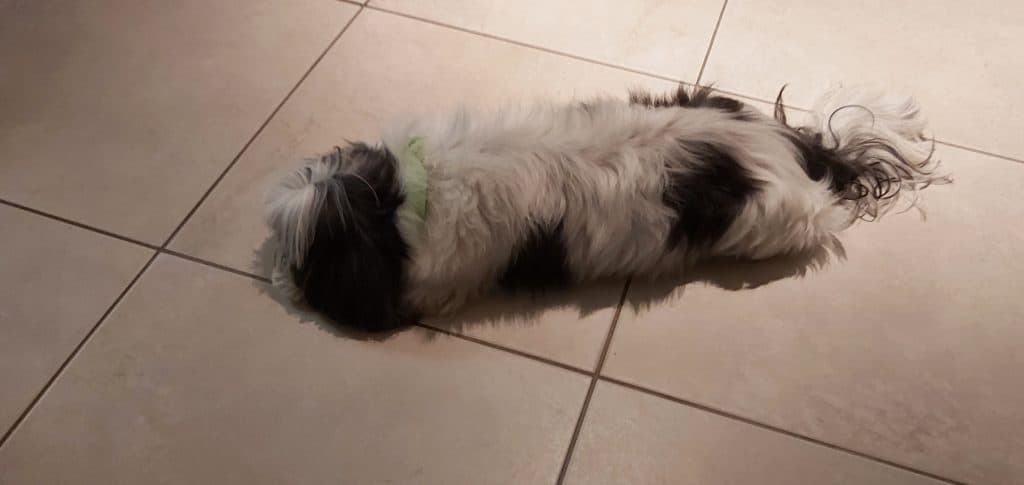If you’ve noticed your beloved four-legged friend suddenly sleeping on the floor instead of in their cozy bed, you may wonder why they’re making this change. The answer could be several things, some of which can easily be resolved with the right knowledge and understanding.
In this blog post, we’ll explore six potential reasons why your dog might be choosing to sleep on the floor. We will also, provide solutions for each one so that you can help create a better sleep experience for your pup. Understanding what is causing this behavior will go a long way toward helping them get back to comfortable sleeping in their bed.

Six reasons why your dog is suddenly sleeping on the floor
There are several potential reasons why your dog is suddenly sleeping on the floor instead of bed or in another area. Here are six of the most common ones:
The dog bed is not comfortable
Reason number one for your dog to start sleeping on the floor instead of their bed could be a lack of comfort on their bed. There could be a few reasons why their bed is not comfortable for them, such as:
- Too Soft or Too Stiff: Just like human beds, dogs have different preferences for the level of firmness in their sleeping surface. If their bed is too soft or too stiff, they may not find it comfortable enough to sleep on.
- Uncomfortable Room Temperature: Dogs also prefer the temperature of their sleeping environment. If the room is too hot or cold, they may be unable to relax and get a good night’s rest on their bed.
- Size of the bed: The size of the bed can have an effect on your dog’s comfort level and preference for sleeping on it. A bed that is too small for your dog can be cramped and uncomfortable, causing them to prefer sleeping on a hard floor. On the other hand, a bed that is too big can make your dog feel insecure and exposed, making them less likely to sleep in it.
Solution: To get your dog to sleep comfortably on his bed, start by ensuring the bed is comfortable and supportive. Consider getting a higher-quality bed with more padding or even an orthopedic bed for extra support. Choose an appropriate size that allows him to stretch out, as dogs prefer to sprawl when sleeping. Make sure the bed material is something he enjoys, such as fleece, cotton, or suede.
You should also place the bed in a quiet area of the home and add a few comfortable blankets so he can burrow into them. Reward your pup with positive reinforcement whenever he lays down on his bed to form good habits around it.
Physical health issues or discomfort
Your dog may be sleeping on the floor instead of their bed due to physical health issues or discomfort caused by aging. An older dog will have various health conditions, like arthritis or joint pain, making it difficult for them to climb steps or get onto the furniture.
In addition, they may also suffer from a reduced sense of balance or weakness in their legs, making it hard for them to stay upright on higher surfaces. These factors make sleeping on the floor much more comfortable and safer than trying to manage climbing up onto furniture to reach their bed.
Solution: It is essential to provide appropriate care for the condition to reduce the discomfort for your dog. This may include providing anti-inflammatory medications under the supervision of a veterinarian, along with some additional physical support using orthopedic dog beds.
The orthopedic bed will provide extra cushioning and support for your dog’s joints and muscles while recuperating.

Separation Anxiety Issues
Separation anxiety is another reason why your dog is suddenly sleeping on the floor instead of bed. Separation anxiety can occur when a dog is left alone for extended periods and can cause them to become anxious, fearful, or depressed.
The anxiety may lead them to seek comfort in a new space, such as the floor; often, it’s seen as one last-ditch effort to be close to their owner’s space.
It’s important to give them extra attention and affection while you’re home and increase their exercise and mental stimulation while you’re away.
Solution: To help your dog with separation anxiety sleep in his bed and not on the floor, start by establishing a strict sleeping routine. Make sure that at the same time every night, you take your dog to his designated spot and ask him to lie down.
Praise him when he does and give him an appropriate reward. If he gets up, calmly return him to his bed. Keep up this routine until he is comfortable going there on command; then, move away from the bed once he is comfortably lying there.
Provide a blanket or toy with familiar smells or noises near their bed, so they feel safe and secure even when you are not present. Additionally, ensure that their sleeping area is free from any stimulation; lights should be dimmed, toys put away, and sounds minimized.
Instinctive Behaviors like cooling off during summer months
Dogs may exhibit different sleeping behaviors in the summer months, such as sleeping on the floor instead of their bed. This instinctive behavior can help keep them cool in hot weather. The floor provides a cooler surface since it isn’t covered with blankets and sheets like a bed is.
Dogs may also curl up close to vents or fans, as the circulated air will help keep them cool. Additionally, some dogs will go outside during the night for cooler air or lay against tile or hardwood floors that don’t retain heat as carpets do.
Solution: To get your dog to sleep in his bed during the summer, start by ensuring that the bed is comfortable and inviting. Place some of his favorite toys or blankets on the bed so he will be drawn to them. You can also give him a treat when he sleeps on it, reinforcing the positive behavior you want to see.
During the day, put him in his bed for short naps or just for cuddle time so he starts associating it with comfort and relaxation. Lastly, ensure that his bed is in a calm and comfortable area of your house; this will help keep your pup from wanting to find other spots with better airflow during hot weather!
Comfort and security
It is possible that your dog’s sudden wish to sleep on the floor instead of its bed can be attributed to a need for comfort and security. Your pet might feel uncomfortable sleeping on its bed due to a change in temperature or a different cushion material. Maybe it is trying to stay close to you as it feels safer on the ground. It may also find the coolness of tiled or hardwood floors more comfortable than synthetic, cushioned beds.
Solution: Nothing; Let sleeping dogs lie.

Lack of training
Your dog may be sleeping on the floor instead of his bed due to a lack of training. If your dog has never been taught that his bed is where he should sleep, then he may not realize that it is a place for him to rest.
Additionally, if your dog has not been given enough time and attention throughout the day, this could make him feel more comfortable on the floor than in his bed.
Solution: To ensure that your pup develops the necessary habits for sleeping in his own space, it is important to provide consistent training and spend quality time with them each day. More on this later.
Does sleeping on the floor hurt dogs?
Sleeping on the floor can cause discomfort for dogs, depending on the breed and sleeping habits. It is hard for a dog to find support and relaxation when sleeping on a flat surface, so this may lead to sore muscles and joints in some cases.
Some breeds such as Greyhounds, Border Collies, and German Shepherds are more prone to muscular issues due to their anatomy. However, providing a soft mattress or large cushion (especially if they have arthritis) can help alleviate any potential discomfort caused by the hard floor.
Additionally, allowing your dog access to different surfaces throughout the day can help build muscle tone that will make it easier for them to get comfortable when lying down on the ground.
How to train your dog to sleep in its bed?
Training your dog to start sleeping in its own bed requires consistency, patience, and positive reinforcement. Start by introducing them to the new bed gradually; place it near the area where your dog usually sleeps and allow him to explore it for a few days.
During this time, reward any positive behavior towards the bed with treats. When he is comfortable sleeping in his new spot, start moving the bed further away from your own bed each night until it is in its desired position.
Additionally, provide plenty of praise when your dog chooses to remain in their own sleeping spot through the night.
If necessary, put a nightlight nearby so they can feel more secure while they are settling in. In addition, utilize calming methods such as aromatherapy or white noise to help relax them during their nap times.
With this combination of rewards and support, you will be able to encourage your pup to stay comfortably in its own spot all day long.
FAQs
Why is my dog no longer sleeping throughout the night?
It could be that your dog’s sleeping habits have changed due to age, a change in diet, an underlying health issue, fear or anxiety, or environmental factors. If there are no obvious physical causes, it could be that your pooch is experiencing stress of some kind.
Stress can cause restlessness during the night and can be caused by lack of exercise and boredom during the day, changes to their routine or environment, loud noises, or other disturbances at night such as fireworks or thunderstorms.
How often should you replace a dog bed?
Replacing a dog bed should be based on how much wear and tear the bed has experienced. Factors like how often the bed is used, if it’s being used outdoors in harsh conditions, whether or not the dog scratches or chews on it, and even the size of your dog can all affect how often a dog bed needs to be replaced.
Generally speaking, an indoor dog bed may last up to two years depending on its use while an outdoor dog bed may need to be replaced more frequently due to weathering and dirt. If your pooch tends to chew on their beds or if you notice signs of wear such as bumps and bends in foam filling then it’s time to replace the bed as soon as possible.
How many dog beds should a dog have?
Having multiple dog beds is a great way to keep your pet comfortable and provide them with adequate rest. I have one bed in the main room for sleeping at night, one in the basement for when it’s too hot upstairs or when my pup wants some extra privacy, and an outdoor bed so they can lie down and relax while enjoying some fresh air. This way, my dog has options throughout the house, depending on their needs and where they want to curl up.
Having two or three beds is a great way to make sure your dog feels safe and content while getting good rest at home.
Final thoughts: Why dog is suddenly sleeping on the floor instead of bed?
There can be many reasons why your dog is suddenly sleeping on the floor instead of its cushioned comfy bed. It’s important to understand the reasons, as this could indicate an underlying health issue. While some dogs may simply feel more comfortable sleeping on the ground, other causes could include age-related issues, joint pain, or stress. You should also take into account your own home environment; if there are any factors that could be causing distress or discomfort for your pet then they must be addressed.
Above all else, remember to show them lots of love and keep a watchful eye for any potential health issues or other causes behind your pet’s sudden change in sleeping habits.
Recent Posts
As a dog owner, you want to ensure that you take proper care of your furry companion. A common question that many pet owners have is, "Can I walk my dog 30 minutes after eating?" Understanding the...
Have you ever considered getting an elevated dog bed for your furry friend, but wondered if it's worth the investment? If so, you're not alone. As dog owners, we all want to provide the best care for...

